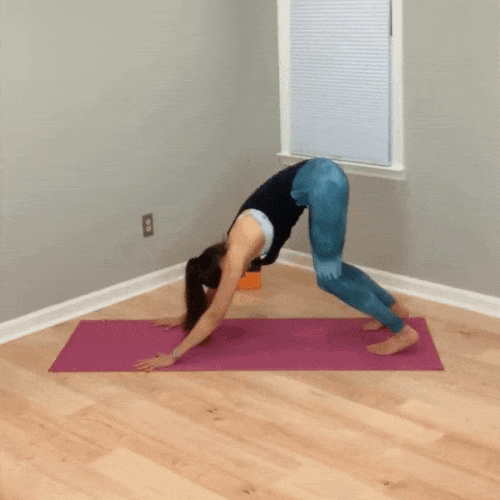What's the Right Length for Downward Dog?
This blog post was first sent to Jenni’s email list as an email newsletter. Sign up for the JRY email newsletter here!
How far apart should our hands and feet be in downward dog? Is there one universal alignment that everyone should use?
Are there different down dog alignments for different bodies, and if so, how do we know what’s best for our own body?
Although we practice down dog in nearly every yoga class(!), we don't often stop to examine this integral aspect of the pose.
But understanding how long our down dog should be can help us find more benefit from this foundational yoga asana.
Here’s my movement science-based explanation for how to find the right down dog length for you (and for your students if you’re a yoga teacher!).
The "Plank Length" Rule for Downward Dog
In my experience, one common instruction we’re taught is that our stride length in down dog should be the same as it is in plank pose.
The idea is that if we start in plank, we shouldn't move our hands and feet from where they are as we press back into down dog. That is supposedly our "correct" length for down dog.
The “plank length” rule for down dog: start in plank and keep your hands and feet where they are as you transition to down dog.
However, for many of us, a plank-length down dog ends up being a longer down dog than we're used to, and we tend to inch our feet forward when we arrive in down dog from plank (which shortens our stride).
Here’s what the sneaky stepping-forward of our feet looks like when we shorten our plank-length down dog:
We often step our feet forward from a plank-length down dog to shorten our stride.
The reason we tend to step our feet forward is because the shorter our down dog stride is, the less weight is in our arms. This means that the pose becomes easier for us, because we’ve unloaded the upper body a bit.
That's right – a shorter down dog is easier on our upper body than a longer one is!
But is this plank-length down dog the "right" length?
The truth is that it depends on one's individual needs and goals!
We've already established that a shorter down dog is easier for the upper body, while a longer down dog is harder. But there are other factors to consider when it comes to down dog length, as well!
For starters, what about hamstring flexibility in downward dog?
For example, a shorter down dog increases our hip flexion, which stretches the hamstrings more. (Taken to the extreme, imagine a standing forward fold (uttanasana) with your hands on the ground – the shortest down dog of all!)
A yoga student with “tighter” hamstrings may bend their knees in a shorter down dog. But if they lengthen their stride a bit by walking their hands forward, this will lessen the degree of hip flexion, which may help them feel more space in the back of their thighs.
A person with "tight" hamstrings might prefer a longer down dog for this reason.
A yoga student with tighter hamstrings may bend their knees in a short down dog, but find more space in a longer down dog.
The Question of the Calves in Downward Dog
On the other hand, a longer down dog stretches the calves more (because the degree of dorsiflexion at the ankle increases), so a person with "tight" calves might actually like to shorten their down dog.
This is because when we walk our hands closer to our feet in down dog, our calves are stretched less!
As we shorten our down dog length, the calves are stretched less.
Other Considerations for Down Dog Length
We know that a shorter down dog takes some of the work out of the upper body (shoulders) because a shorter down dog sends more load into the lower body.
This means that a yoga student who may be dealing with a shoulder injury might prefer a shorter down dog to temporarily de-load the shoulders.
However, someone who's interested in increasing strength and capacity in their shoulders might choose a longer down dog specifically for the purpose of working and loading the upper body more.
These are just a few factors to consider when it comes to individualizing down dog alignment. (And there are of course more!)
Hopefully these examples demonstrate that the "correct" length for down dog is truly an "it depends" matter. :)
Personally, I think the plank pose length rule is a good place to start as a foundation for down dog, and then we can tailor the pose from there based on individual needs.








